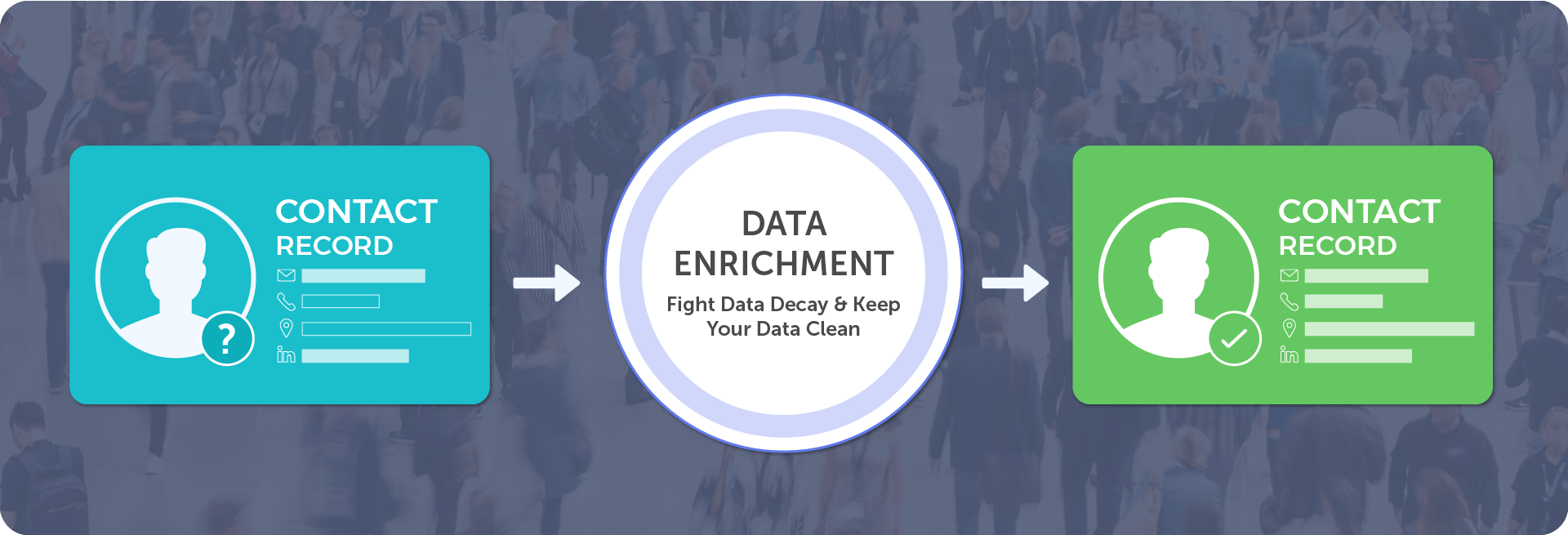Data has become the lifeblood of B2B companies and is used to power marketing, sales, and support. Data is at the core of every decision business leaders make to foster the growth and productivity of their organization.
To derive valid insights from company data and ultimately improve sales, organizations:
- Must have quick access to the data most important to them
- Must be confident that the data they are working with is correct and up-to-date
This is why data enrichment and data cleansing have become crucial in today’s data-driven world of sales. B2B companies are looking for data enrichment providers to ensure that they are making the most of their existing data. In this article, we will help you understand what is data enrichment, when is it important, and why it matters for your sales team and business growth.
What is Data Enrichment?

Data enrichment is the method of integrating raw data from your internal resources with data from other internal or external data sets. Enriched data is a valuable commodity as it converts raw data into more useful and informative insights for every organization. The majority of brands conduct data enrichment on their raw data so they can use it for informed decision-making.
Is Data Enrichment and Data Cleansing the Same?
Database maintenance and hygiene grow in importance with each passing quarter. This is consistent with an industry-wide shift toward data-driven decision-making, which has prompted marketers and salespeople to look for scalable database management and growth methods.
The two most commonly used methods for ensuring that marketers and sales professionals can identify and reach the right lead at the right time are data cleansing and data enrichment. Given that both terms are used to maintain a healthy database, marketers and sales teams may struggle to differentiate between the two. They are not, however, the same.
The primary distinction between data enrichment and data cleansing is that cleansing involves correcting inconsistencies and updating or removing obsolete or untrustworthy data. Meanwhile, enrichment is focused on adding data points to the contacts you already have.
We have created a quick read that will help you get a better understanding of what each of these terms means, how they are different, and what you should focus on.
When Do You Need Data Enrichment?
Data enrichment is vital for B2B businesses to stay ahead of the competition and make informed decisions. Here are a few situations where data enrichment is crucial.
1. You Have an Extensive Database
In theory, the larger your database the better. Afterall, the more information you have on more potential customers the more likely you will be able to close deals. However, the larger the database, the more complicated things get if your data is inaccurate or incomplete. Too much inaccurate and incomplete data begins to create a signal vs noise problem where more data actually begins to make you less effective. And even if you start off with perfect data, it’s going to deteriorate at over 30% per year. So, it’s not going to remain reliable for long.
This is where data enrichment companies help you to eliminate data inaccuracies and incomplete data. Data enrichment becomes essential for more effective, cleaner data processing, and more focused campaigns.
2. You Are Planning an ABM Campaign
Successful account-based marketing includes an informed, data-driven approach that targets individuals with the most critical challenges when making purchase decisions. ABM means targeting the right people, at the right companies, at the right time, and with the right content.
Without complete and accurate data, no amount of tailored content, segmentation, strategic messaging, etc. will make up for not being able to target the right decision-makers or the right companies. Data enrichment is the best way to ensure you have the most accurate, up-to-date profiles for your leads and clients.
3. You Rely on Inbound or Event Lead Sources
Every marketer knows that optimizing inbound lead forms is a delicate balancing act. The number of form submissions you receive is inversely proportional to the number of data points you need to gather. So, for every additional field you add to a form, you will receive fewer submissions. However, you need to equip your sales and marketing teams with enough data points to be able to prioritize the right accounts and contacts as well as the contact information needed to reach out to and connect with them.
Similarly, for organizations that rely heavily on events for lead generation, gathering all of the necessary information to optimize follow up is often outside of their control. Most events determine which data points they require registrants and attendees to submit and often what they require will not match what you need to be effective in your follow up.
And regardless of source, you have very little control over what information leads choose to provide. For most lead sources you have few options for preventing leads from entering personal, generic, or inaccurate information in your forms. And there’s always the legitimate accidents and mistakes they make in filling out the form.
4. You Are Expanding Your Offering
Expanding offerings or targeting new segments is one of the most challenging undertakings you can take on. Before expanding into a new space you have to be confident in your footing. By compiling complete information about your audience, you can minimize your risks and ensure the success of your new campaigns.
Why Do You Need Data Enrichment?
Data enrichment has several valuable applications. However, there are a few B2B campaign-specific problems that data enrichment can potentially address successfully.
1. Advanced Segmentation
Segmenting your audiences will generate a much higher return on your campaigns by focusing your efforts and tailoring your content and outreach. As your campaigns are more specific to groups, they can uncover new opportunities and provide tremendous potential for growth. Data enrichment will allow you to take a laser-focused approach and create accurate segmentation categories.
Let us assume that you wanted to promote marketing content to all heads of technology at education institutions with over 20,000 students for your EdTech Product. If you don’t have the data you need to identify the right education institutions as well as the heads of technology at those organizations, then you will waste a lot of time and effort reaching out to the wrong targets and will likely miss many opportunities you should have prioritized.
2. Advanced Lead Scoring
Evaluating and ranking your leads will help set clear goals for your sales and marketing team. That said, if lead scoring is ad hoc, or not done at all, the effectiveness of your lead generation campaigns will suffer. When you have little knowledge to go on, lead scoring becomes even more challenging. In-depth customer profiles can be accurately scored, however scoring incomplete profiles can be guesswork at best.
Data enrichment can move a customer profile from the “incomplete” to the “in-depth” column, allowing you to assign a meaningful and precise score to the leads. Sales and marketing teams can work together to identify the most valuable data points for lead scoring.
3. Personalization
Customers know their data is out there. While they may have mixed feelings about seeing it used for outreach, there’s an expectation that a company that really wants their business will do their homework and make thoughtful personalized overtures. In B2B, it’s not just a matter of meeting expectations. Knowing how to gain the attention of the decision-makers you’re trying to convert, and demonstrating that you already understand their pain points and priorities, can make or break a deal.
Data enrichment helps ambitious B2B marketers and salespeople to take personalization even further by understanding other details without asking them or wasting valuable time researching the requisite details they need to be confident in their outreach.
4. Data Compliance
The application of data enrichment processes to ensure compliance with data privacy regulations is less known than the previous use cases but equally important. Laws such as CCPA and GDPR set restrictions on what types and how long consumer data can be stored as well as what can be done with it.
Data enrichment can help ensure compliance with regulations like GDPR, do-not-call lists, and any other regulatory requirements. This means not only that the data is correct and complete but also legal. Even if regulations change in the future, continuous enrichment will maintain your data’s usefulness.
Using Data Enrichment for Lead Qualification
The primary goal of revenue marketing is straightforward: find new leads and convert them into customers. Traditionally, marketing generates leads, which are then passed on to sales in the hope that they will convert into customers.
However, after a few follow-up calls, sales frequently conclude that marketing leads are unusable, i.e., unqualified prospects who are unwilling to purchase.
Typically, this is where the counterproductive pointing-the-finger game between marketing and sales begins. The tension stems from dissatisfied sales reps who have spent too much time on bad leads and struggle to hit quota with the data they’ve been given.
This is where lead qualification comes into play. Given the slowness of traditional lead qualification processes, data enrichment becomes the catalyst that accelerates the entire qualification process.
How? By allowing careful targeting based on firmographics, technographics, and more. Here’s a detailed explanation.
Using Data Enrichment to Improve Conversions
B2B marketers are increasing their efforts to keep their database clean and up-to-date.
Unlike standard info, enriched data has an infinite depth of knowledge to deliver automated decisions with greater efficiency.
As a result, enriched data can be trusted to carry out the most crucial B2B marketing strategies:
- Strengthening ABM strategies with the right target account list
- Improving segmentation and targeting by accessing more crucial data
- Staying on top of the decision-makers from your target accounts
- Gaining intelligence on what stimulates revenue and motivates decision-makers
- Making stronger ad setup and creating more tailored content
You can read a complete article on how data enrichment can help you to improve conversions.
Using Data Enrichment to Increase Form Submissions
The amount of information requested on the form has a significant impact on conversion rates. Forms can be as simple as a name and email field, or they can request everything from company size to phone number.
If you have a landing page with a lot of traffic but no one is submitting your lead generation form with 5 to 8 fields, most marketers will reduce the number of form fields as a corrective action.
On most signup forms, however, marketers will risk additional questions to learn more about the potential lead. While these questions may be beneficial to the marketing and sales teams, they may be off-putting to the person attempting to complete the form and move on.
Data enrichment lets you keep the form as short as the email address and name, and provides you additional data without asking your leads.
Want to dive deeper into how exactly this works? Read more here.
SalesIntel’s Data Enrichment Feature
SalesIntel allows you to connect different data points to your current B2B data and prospecting lists.
While you will have many data enrichment vendors out there, here are some of the primary benefits that SalesIntel’s Data Enrichment feature brings to your plate:
- Get Advanced-Level B2B Data: Get complete data in a few clicks from our data portal to take your prospecting to the next level.
- Increase Form Submission with Fewer Fields: Fewer form fields mean more lead form submissions. If you are relying on inbound leads, just ask for the email Id and we will help you fill the missing data.
- Append Existing & Incoming Leads: You can also enrich existing data with as little as an email address, and SalesIntel can automatically append the missing company and contact information you need to execute your sales and marketing campaigns.
Automating Data Enrichment Using SalesIntel
For accurate lead routing and assignment to sales, enriched lead data is required. This enables the lead owner to respond quickly with messaging that is tailored to demographic, firmographic, and technological data. Because 35-50% of sales go to the first vendor to respond, having complete information about your lead is essential in a highly competitive B2B market.
So, there is no doubt that data enrichment adds significant value to the B2B sales and marketing strategy. However, you must decide whether to enrich the data manually or automatically.
When it comes to picking one over the other, automating the data enrichment process has proven to be the clear winner with increased accuracy and time savings over manual data work.
Automating your data enrichment process with SalesIntel comes with many benefits for marketers and sales professionals. Here’s more information about its benefits with the steps to configure and automate data enrichment in your CRM.
Data Enrichment for Salesforce Users
SalesIntel allows you to run a data enrichment activity in Salesforce in addition to sending contact and company data directly to the CRM.
You can run one-time enrichments or set up auto enrichment for accounts, leads, and contacts between SalesIntel and Salesforce.
Here’s a complete video guide for you here.
Data Enrichment for Marketo Users
In addition to being able to export contacts directly to Marketo, our users can now use Data Enrichment for Marketo to run one-time enrichments or set up auto enrichment for leads and contacts.
This new functionality is completely customizable for any enrichment you require and can be used in a variety of ways, but before you can begin enriching your data, you must first configure the SalesIntel Data Enrichment Webhook.
Here’s a complete video for the Marketo Users.
So, get ready to take your B2B prospecting to the next level with data enrichment. Bring lead enrichment to your tech stack and capitalize on every opportunity by mastering data-driven features like lead scoring, segmentation & personalization.
FAQs
What is Data Enrichment?
Data enrichment is the process of appending missing or new information to existing data records, making them more complete and valuable. This involves integrating external data sources to enhance profiles with details like firmographics, technographics, or contact information.
What are the Benefits of Data Enrichment?
Data enrichment improves lead qualification, enhances marketing personalization, and enables more accurate sales targeting. It provides a comprehensive view of customers and prospects, leading to better decision-making, increased conversion rates, and more efficient resource allocation.
What are the Key Steps in Data Enrichment?
The key steps involve identifying the data to be enriched and defining enrichment goals, selecting relevant external data sources, mapping and merging new data with existing records, and validating the enriched data to ensure accuracy and consistency.
What are the Applications of Data Enrichment?
Sales teams use data enrichment for lead scoring and prospecting, marketing leverages it for segmentation and personalized campaigns, and customer service benefits from a 360-degree view for improved support. It also enhances market analysis and strategic planning across business functions.
What are the Best Practices for Data Enrichment?
Best practices include clearly defining enrichment goals aligned with business objectives, prioritizing data privacy and compliance, and regularly auditing enriched data to maintain accuracy. Integrating enrichment into existing workflows ensures data remains valuable and actionable over time.
What are the Challenges in Data Enrichment?
Key challenges include ensuring data quality and accuracy from external sources, managing data privacy and compliance regulations, and integrating diverse datasets seamlessly. Maintaining data consistency across systems and handling large volumes of information requires robust processes and reliable tools.
What are the Recommended Data Enrichment Tools and Platforms?
Recommended tools include CRM-integrated solutions, B2B data providers like SalesIntel, and specialized enrichment APIs. Key considerations are data coverage, accuracy, integration capabilities, and compliance features to efficiently enhance lead data, firmographics, and contact information.
How does Data Enrichment differ from Data Cleansing?
Data enrichment adds new, relevant information to existing data, enhancing its depth and utility, while data cleansing focuses on improving data quality by correcting errors and inconsistencies. Both processes enhance data value and are often used sequentially for optimal results.









